The Seepage and Stability Performance Assessment of a New Drainage System to Increase the Height of a Tailings Dam
Abstract
Featured Application
Abstract
1. Introduction
2. A New Drainage Method for the Tailings Pond
2.1. Layout Method
2.2. Slotted Drainage Pipes
2.3. Drainage Pipe Filter
3. Site Characterization of the Xigou Tailings Dam
3.1. Project Description
3.2. Layout of the Seepage Control System
4. Seepage Control System in the Xigou Tailings Dam with an Increased Height
4.1. The Finite Element Model
4.2. The Substructure Method and Boundary Conditions
4.3. Phreatic Surface of the Tailings Dam
4.4. Numerical Results
4.4.1. Performance Estimation of the Seepage-Proof System
4.4.2. Comparison of the Seepage Results with Different Drainage Conditions
4.4.3. Local Failure Analysis of the Drainage Pipe
- Select the object elements, including the horizontal and upward bending drainage pipes for the three-dimensional finite element model, and then set the percentage of the local failure.
- Introduce the concept of random numbers, and sample them randomly according to the uniform distribution. When the ratio, which denotes the sum of the volume of the damaged elements to the total volume of drainage elements, reaches the set percentage of local failure, the sampling is stopped.
- Modify the permeability coefficients of the random sampling elements to be consistent with the nearby tailings material.
4.4.4. Sensitivity Analysis of the Tailings Material
4.4.5. Sensitivity Analysis of the Drainage Pipe Spacing
5. Stability Analysis
6. Conclusions
- Compared with only setting horizontal drainage pipes or with no drainage pipes, the performance of the new drainage system not only effectively reduced the seepage pressure and depressed the water table but also improved the overall groundwater movement trend and the local seepage field.
- A stochastic simulation analysis was carried out for analyzing the local failure of the new drainage system, in which 5% and 10% of local blockages have a marginal influence on the seepage field, and the upper and lower envelopes show a lower deviation from the free surface without local failure. The maximum seepage gradients reached 1.43 for the 5% local failure case and 1.57 for the 10% local failure case, but these values were still within the permissive seepage gradient.
- The sensitivity analysis of the tailings material showed that the performance of the seepage control system was insensitive to the change in the horizontal and vertical permeability coefficients. The sensitivity analysis of the drainage spacing indicated that the designed 10 m pipe spacing was suitable for the drainage pipe arrangement.
- Utilizing the LEM, the potential failure surface was evaluated, and the corresponding FOSs were obtained at different water levels. Comparing the FOSs under various drainage system conditions, it was obvious that the cases without drainage and with horizontal drainage seemed to lead to an unstable tailings dam under the normal water level or the extremely high water level. However, when the new drainage system was implemented properly, the tailings dam was safe under a variety of working conditions.
Author Contributions
Funding
Conflicts of Interest
References
- Kossoff, D.; Dubbin, W.E.; Alfredsson, M.; Edwards, S.J.; Macklin, M.G.; Hudson-Edwards, K.A. Mine tailings dams: characteristics, failure, environmental impacts, and remediation. Appl. Geochem. 2014, 51, 229–245. [Google Scholar] [CrossRef]
- Shamsai, A.; Pak, A.; Bateni, S.M.; Ayatollahi, S.A.H. Geotechnical characteristics of copper mine tailings: A case study. Geotech. Geol. Eng. 2007, 25, 591–602. [Google Scholar] [CrossRef]
- Martin, T.E.; McRoberts, E.C. Some considerations in the stability analysis of upstream tailings dams. In Proceedings of the Sixth International Conference on Tailings and Mine Waste, Rotterdam, Netherlands, 24–27 January 1999; Volume 99, pp. 287–302. Available online: http://w3.cenn.org/cenn_projects/BfW_mining/Training/Managing%20Effects%20of%20Major%20Mines/Reference%20Materials/Tailing/Martin2002b.pdf (accessed on 5 October 2018).
- Yin, G.Z.; Li, G.Z.; Wei, Z.A.; Wan, L.; Shui, G.H.; Jing, X.F. Stability analysis of a copper tailings dam via laboratory model tests: A Chinese case study. Miner. Eng. 2011, 24, 122–130. [Google Scholar] [CrossRef]
- Zandarin, M.T.; Decop, L.A.; Rodriguez, R.; Zabala, F. The role of capillary water in the stability of tailing dams. Eng. Geol. 2009, 105, 108–118. [Google Scholar] [CrossRef]
- Vick, S.D. Tailings dam failure at Omai in Guyana. Miner. Eng. 1996, 11, 34–37. [Google Scholar]
- WISE. Chronology of Major Tailings Dam Failures. Available online: http://www.wise-uranium.org/mdaf.html (accessed on 29 August 2018).
- Psarropoulos, P.N.; Tsompanakis, Y. Stability of tailings dams under static and seismic loading. Can. Geotech. J. 2008, 45, 663–675. [Google Scholar] [CrossRef]
- Jakka, R.S.; Ramana, G.V.; Datta, M. Seismic slope stability of embankments constructed with pond ash. Geotech. Geol. Eng. 2011, 29, 821–835. [Google Scholar] [CrossRef]
- Rico, M.; Benito, G.; Diez-Herrero, A. Floods from tailings dam failures. J. Hazard. Mater. 2008, 154, 79–87. [Google Scholar] [CrossRef] [PubMed]
- Rico, M.; Benito, G.; Salgueiro, A.R.; Diez-Herrero, A.; Pereira, H.G. Reported tailings dam failures. A review of the European incidents in the worldwide context. J. Hazard. Mater. 2008, 152, 846–852. [Google Scholar] [CrossRef] [PubMed]
- Kwak, M.; James, D.F.; Klein, K.A. Flow behaviour of tailings paste for surface disposal. Int. J. Miner. Process. 2005, 77, 139–153. [Google Scholar] [CrossRef]
- Kollikkathara, N.; Feng, H.; Stern, E. A purview of waste management evolution: special emphasis on USA. Waste Manag. 2009, 29, 974–985. [Google Scholar] [CrossRef] [PubMed]
- Reid, C.; Becaert, V.; Aubertin, M.; Rosenbaum, R.K.; Deschenes, L. Life cycle assessment of mine tailings management in Canada. J. Clean. Prod. 2009, 17, 471–479. [Google Scholar] [CrossRef]
- Wei, Z.A.; Yin, G.Z.; Wan, L.; Li, G.Z. A case study on a geotechnical investigation of drainage methods for heightening a tailings dam. Environ. Earth Sci. 2016, 75, 106. [Google Scholar] [CrossRef]
- Xu, B.T.; Wang, Y.Y. Stability analysis of the Lingshan gold mine tailings dam under conditions of a raised dam height. Bull. Eng. Geol. Environ. 2015, 74, 151–161. [Google Scholar] [CrossRef]
- Wang, T.; Zhou, Y.; Lv, Q.; Zhu, Y.L.; Jiang, C. A safety assessment of the new Xiangyun phosphogypsum tailings pond. Miner. Eng. 2011, 24, 1084–1090. [Google Scholar] [CrossRef]
- Dixon-Hardy, D.W.; Engels, J.M. Guidelines and recommendations for the safe operation of tailings management facilities. Environ. Eng. Sci. 2007, 24, 625–637. [Google Scholar] [CrossRef]
- Zhang, D.M.; Li, S.; Wang, X.M.; He, Y. Super large-scale filtered tailing disposal on coal-mining subsidence land. Pol. J. Environ. Stud. 2017, 26, 1855–1863. [Google Scholar] [CrossRef]
- Fu, W.T.; Li, H.J.; Bo, F.Z. Discussion on the burial of drainage tube in tailings dam. Met. Mine 2010, S, 44–46. [Google Scholar]
- Jin, S.L.; Xu, H.D.; Zhang, W.; Yan, H. Research situation of drainage technology of tailings dam. Mod. Minging 2012, 28, 35–38. [Google Scholar]
- Li, X.; Chen, Y.F.; Hu, R.; Yang, Z.B. Towards an optimization design of seepage control: A case study in dam engineering. Sci. China-Technol. Sci. 2017, 60, 1–14. [Google Scholar] [CrossRef]
- Li, Y.; Chen, Y.F.; Jiang, Q.H.; Hu, R.; Zhou, C.B. Performance assessment and optimization of seepage control system: A numerical case study for Kala underground powerhouse. Comput. Geotech. 2014, 55, 306–315. [Google Scholar] [CrossRef]
- Wang, L. Analysis of seepage field near a drainage-holes curtain. J. Hydraul. Eng. 1992, 9, 15–20. [Google Scholar]
- Zhao, J.; Shen, Z.Z. Improvement of seepage calculation method for complex drainage system of tailings dam. J. Hohai Univ. (Nat. Sci.) 1997, 25, 110–113. [Google Scholar]
- Chen, Y.F.; Zhou, C.B.; Zheng, H. A numerical solution to seepage problems with complex drainage systems. Comput. Geotech. 2008, 35, 383–393. [Google Scholar] [CrossRef]
- Zhu, Y. Solution to seepage field problem with the technique of improved drainage substructure. Chin. J. Geotech. Eng. 1997, 19, 69–76. [Google Scholar]
- Zheng, H.; Liu, D.F.; Lee, C.F.; Tham, L.G. A new formulation of Signorini’s type for seepage problems with free surfaces. Int. J. Numer. Methods Eng. 2005, 64, 1–16. [Google Scholar] [CrossRef]
- Fu, W.T. Slot drainage tube-a new type drainage tube for tailings dam. Met. Mine 2009, S, 73–74. [Google Scholar]
- Code for Design of Tailings Facilities; GB No. 50863-2013; MOHURD (Ministry of Housing and Urban-Rural Development of the People’s Republic of China): Beijing, China, 2013.
- Chen, Y.F.; Hu, R.; Zhou, C.B.; Li, D.Q.; Rong, G.; Jiang, Q.H. A new classification of seepage control mechanisms in geotechnical engineering. Chin. J. Rock Mech. Eng. 2010, 2, 209–222. [Google Scholar] [CrossRef]
- Xu, T.L.; Wang, Y.B.; Chen, K. Tailings saturation line prediction based on genetic algorithm and BP neural network. J. Intell. Fuzzy Syst. 2016, 30, 1947–1955. [Google Scholar]
- Zhou, C.B.; Liu, W.; Chen, Y.F.; Hu, R.; Wei, K. Inverse modeling of leakage through a rockfill dam foundation during its construction stage using transient flow model, neural network and genetic algorithm. Eng. Geol. 2015, 187, 183–195. [Google Scholar] [CrossRef]
- Gan, L.; Shen, X.Z.; Zhang, H.W. New deformation back analysis method for the creep model parameters using finite element nonlinear method. Cluster. Comput. 2017, 20, 3225–3236. [Google Scholar] [CrossRef]
- Reddi, L.N.; Ming, X.; Hajra, M.G.; Lee, I.M. Permeability reduction of soil filters due to physical clogging. J. Geotech. Geoenviron. Eng. 2000, 126, 236–246. [Google Scholar] [CrossRef]
- Reddi, L.N.; Xiao, M.; Hajra, M.G.; Lee, I.M. Physical clogging of soil filters under constant flow rate versus constant head. Can. Geotech. J. 2005, 42, 804–811. [Google Scholar] [CrossRef]
- Ozcan, N.T.; Ulusay, R.; Isik, N.S. A study on geotechnical characterization and stability of downstream slope of a tailings dam to improve its storage capacity (Turkey). Environ. Earth Sci. 2013, 69, 1871–1890. [Google Scholar] [CrossRef]
- Lane, P.A.; Griffiths, D.V. Assessment of stability of slopes under drawdown conditions. J. Geotech. Geoenviron. Eng. 2000, 126, 443–450. [Google Scholar] [CrossRef]
- Stress-Deformation Modeling with Slope/W 2017 Version: An Engineering Methodology; GEO-SLOPE International Ltd: Calgary, AB, Canada, 2017.
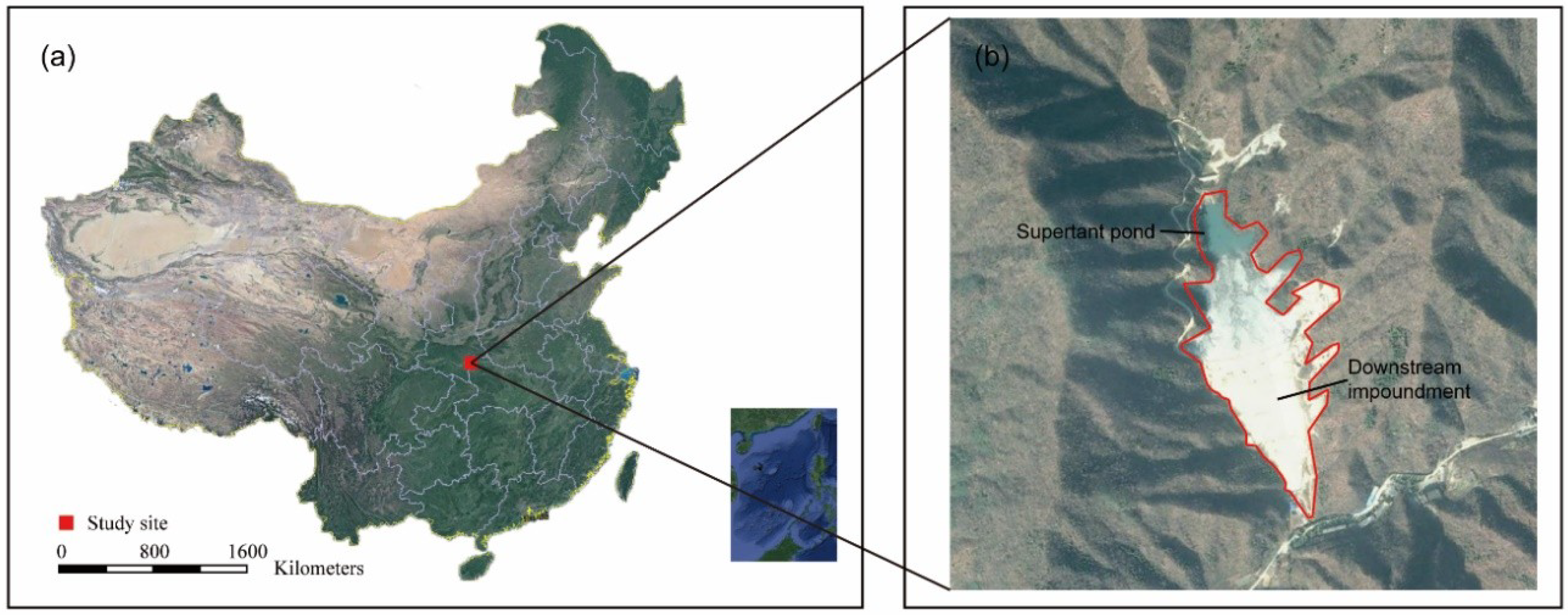

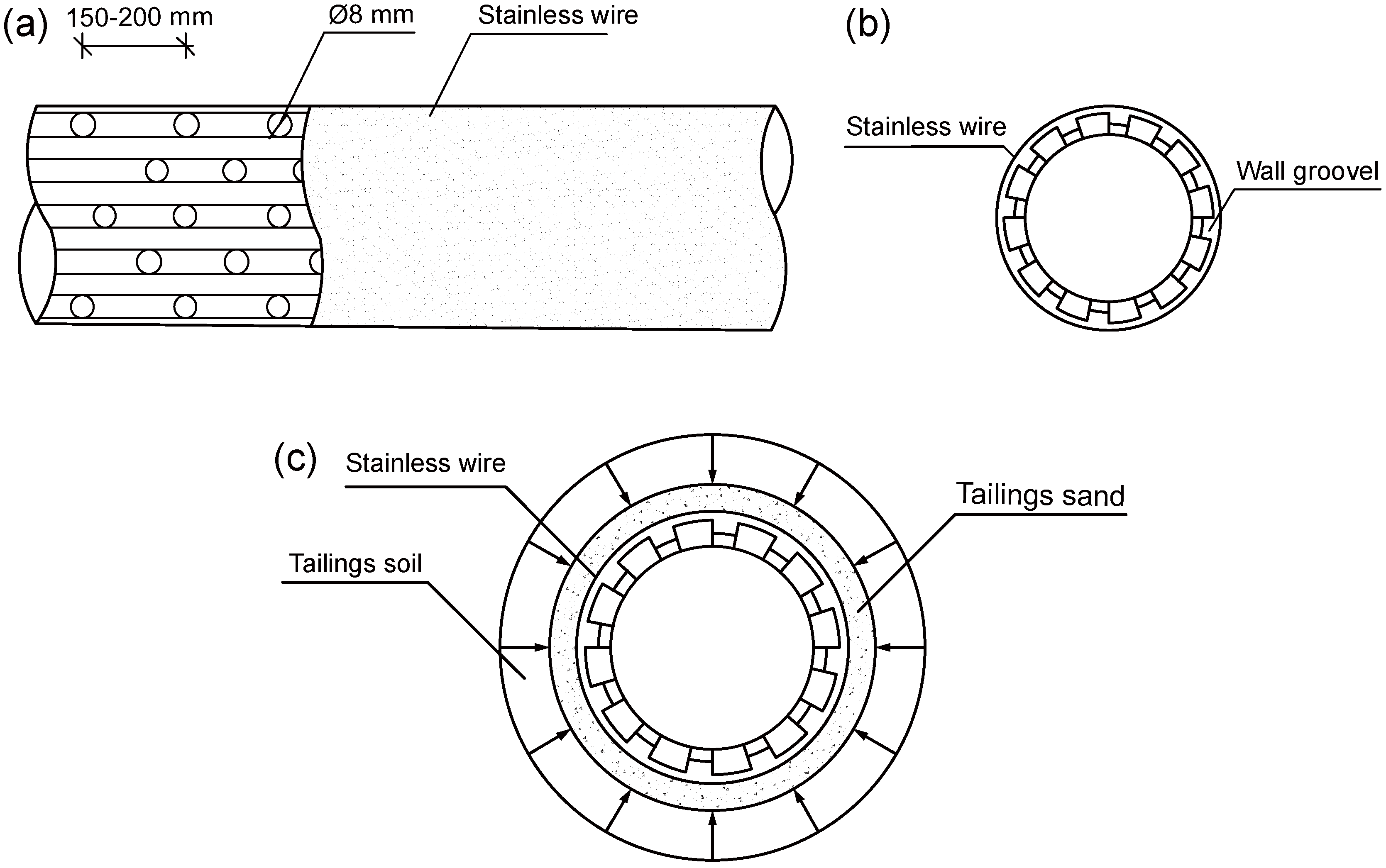

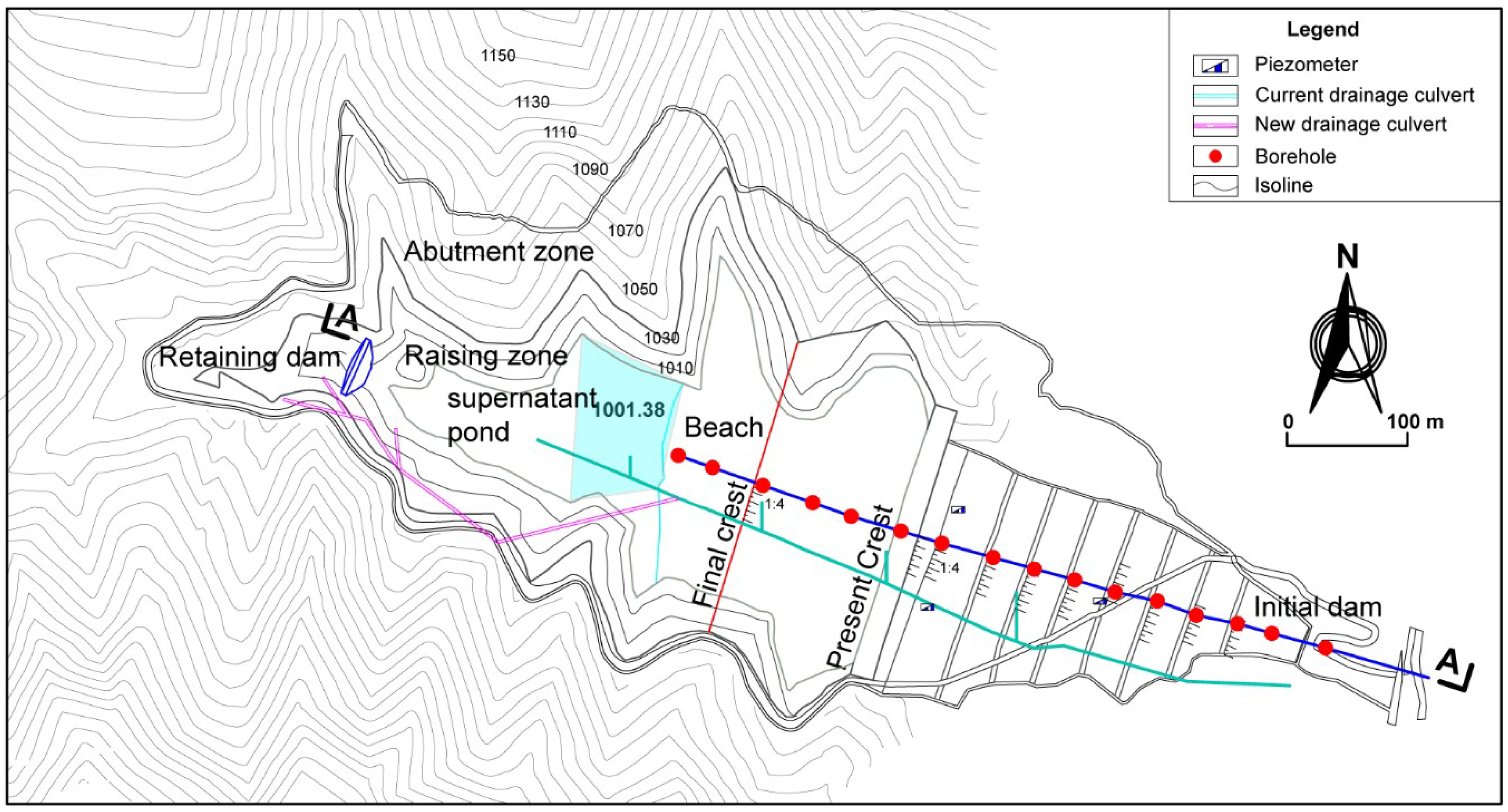

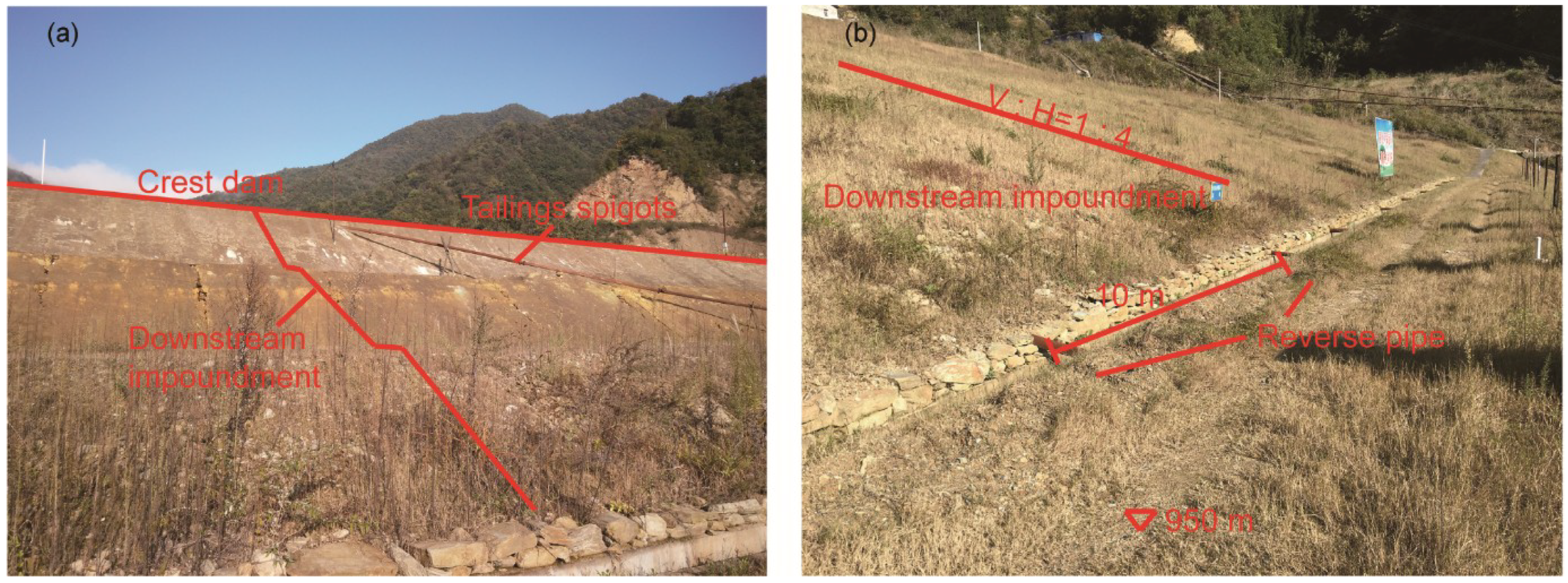
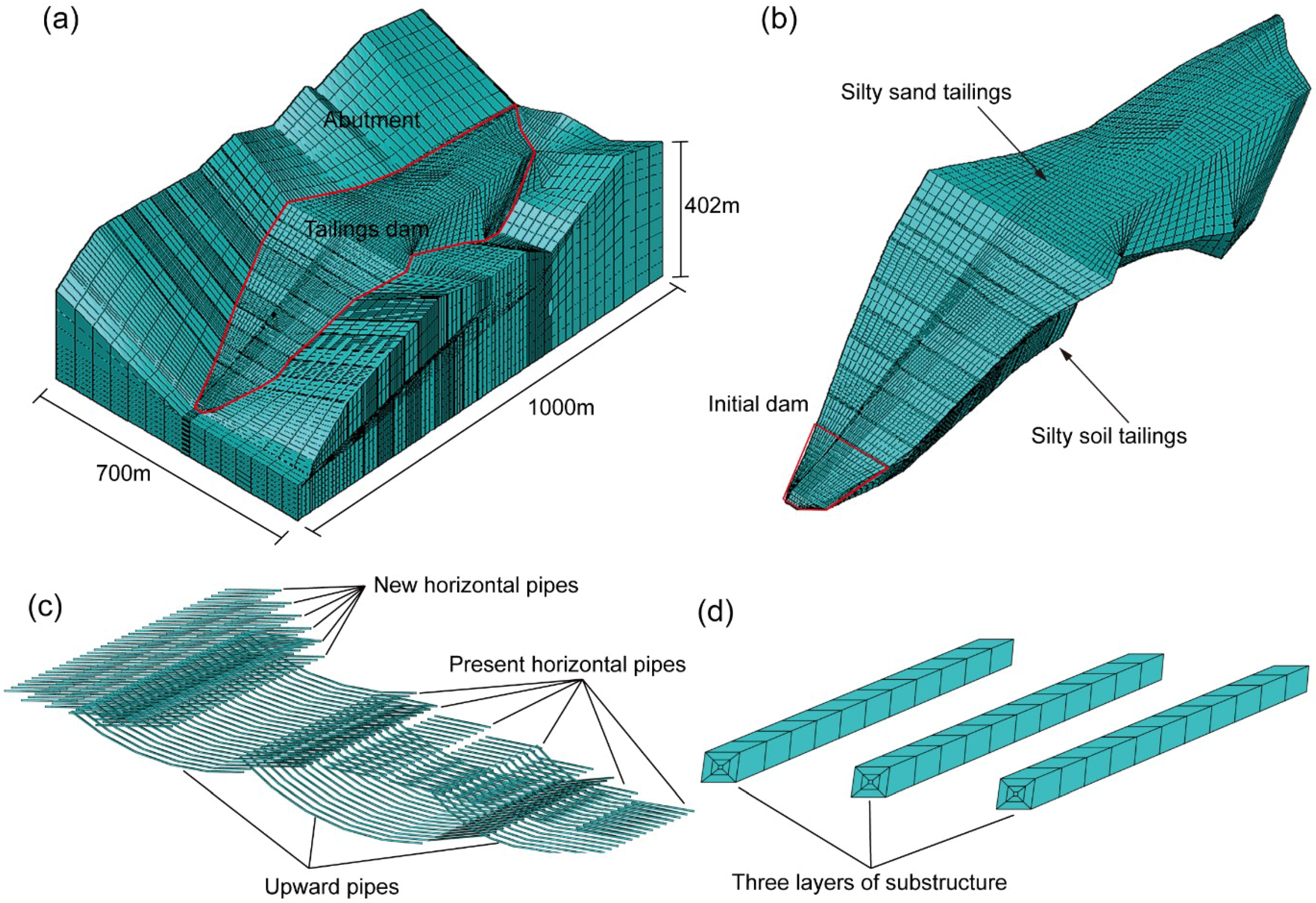
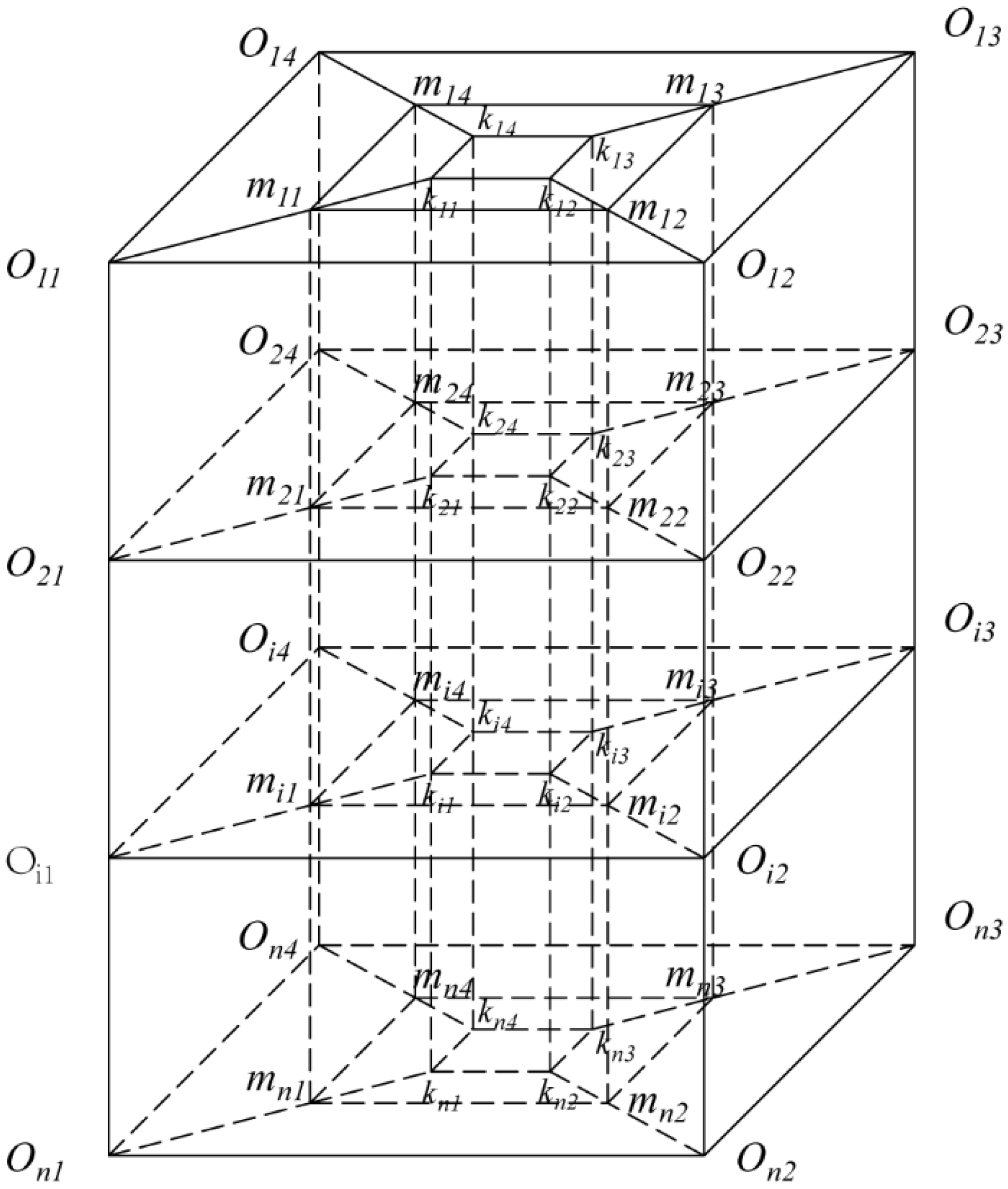
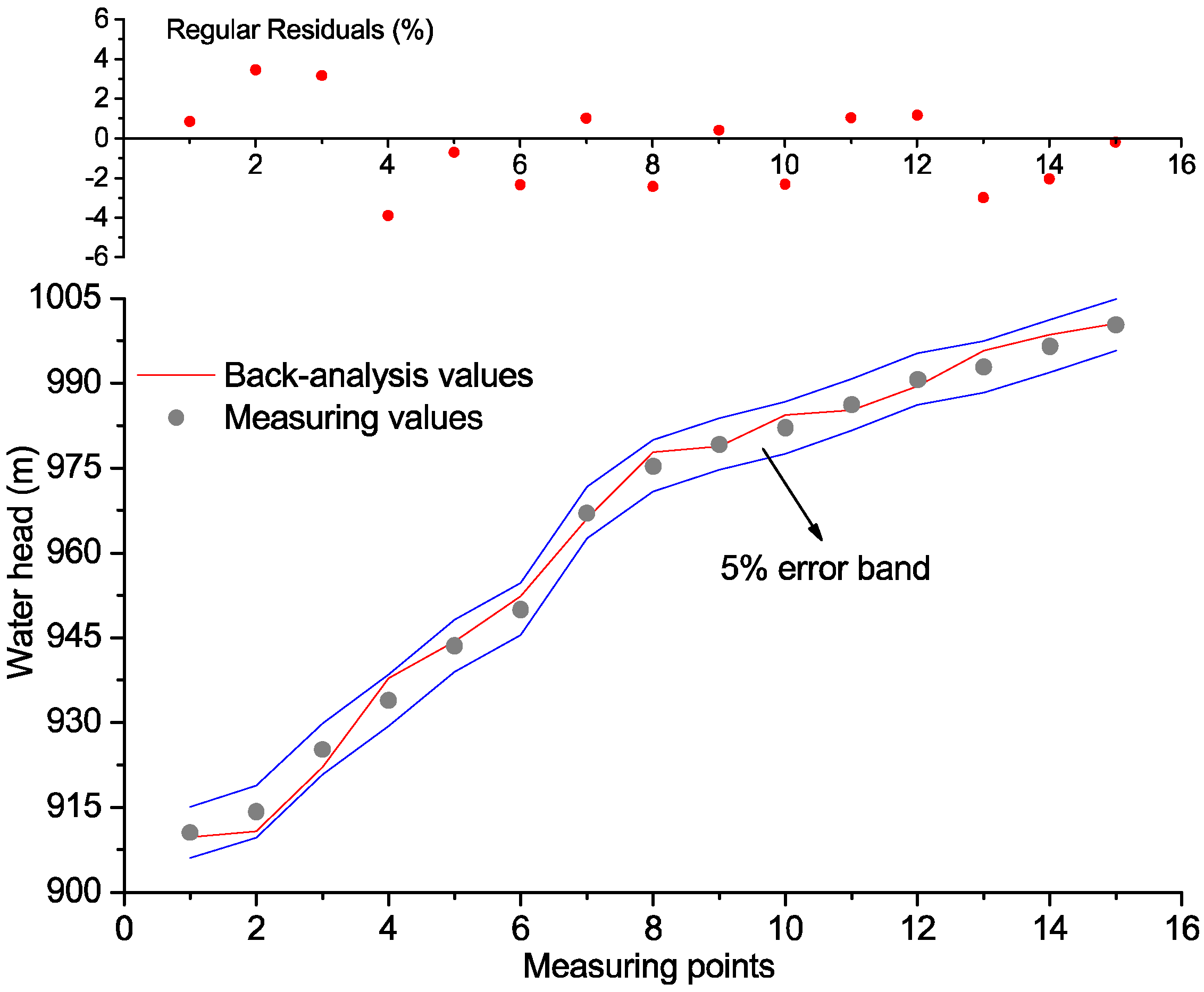


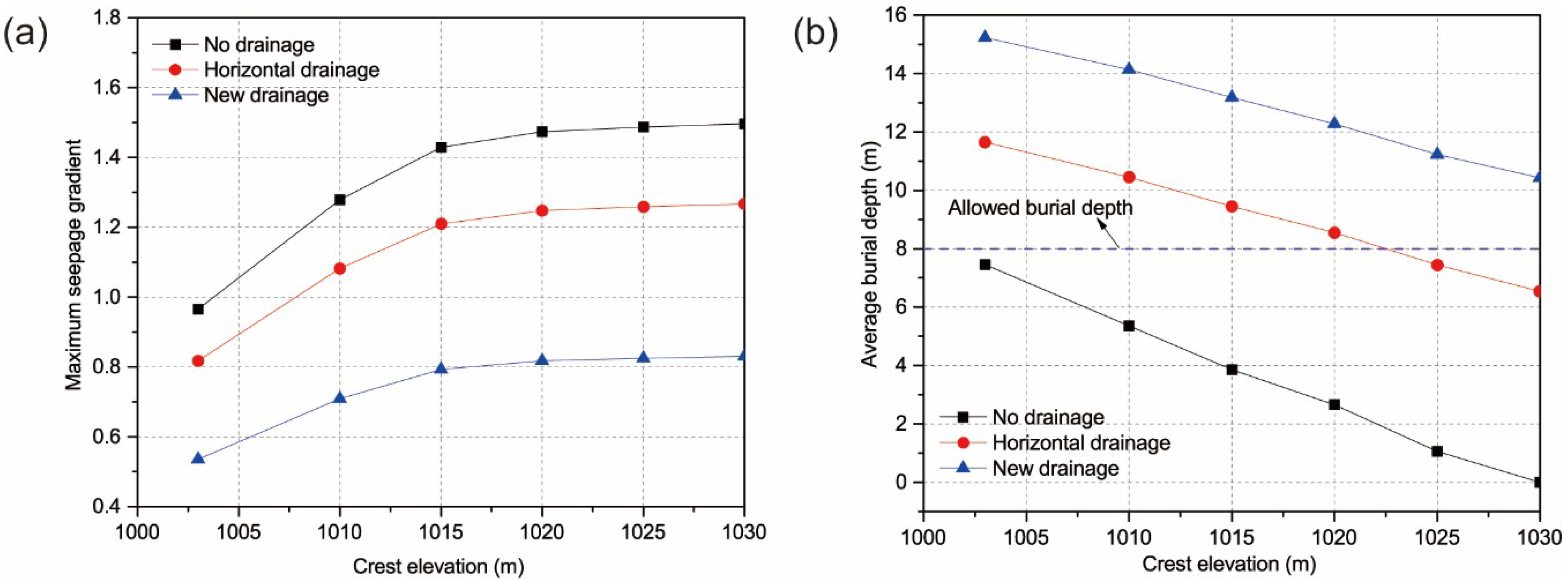
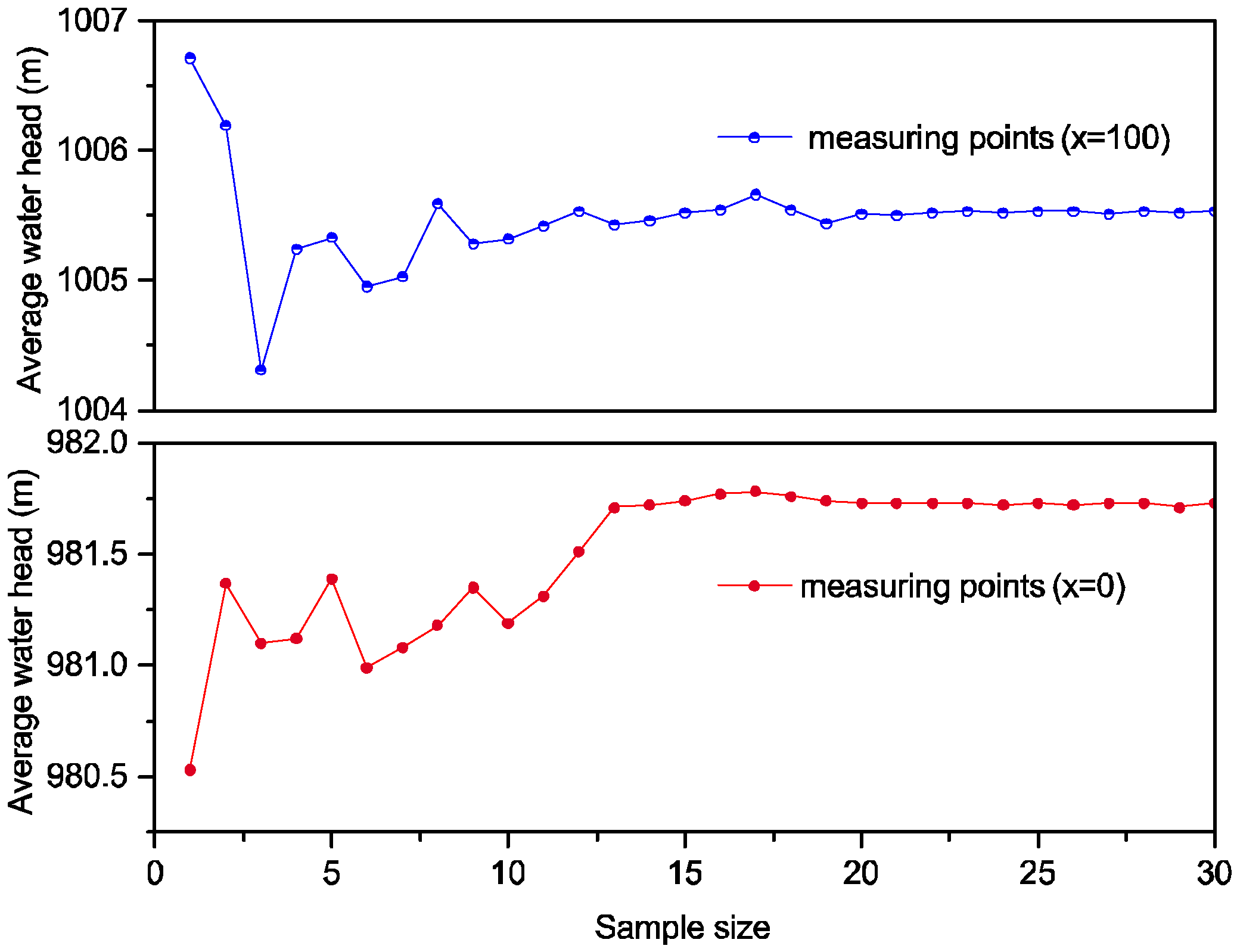
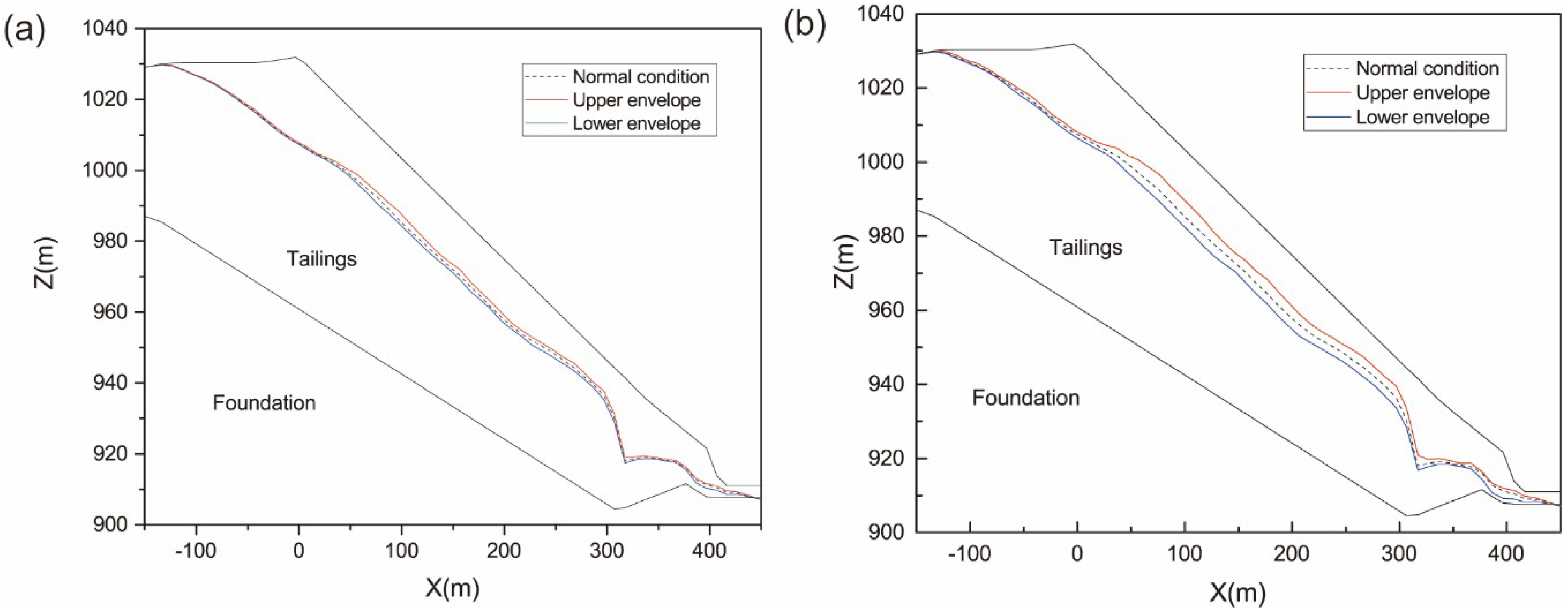
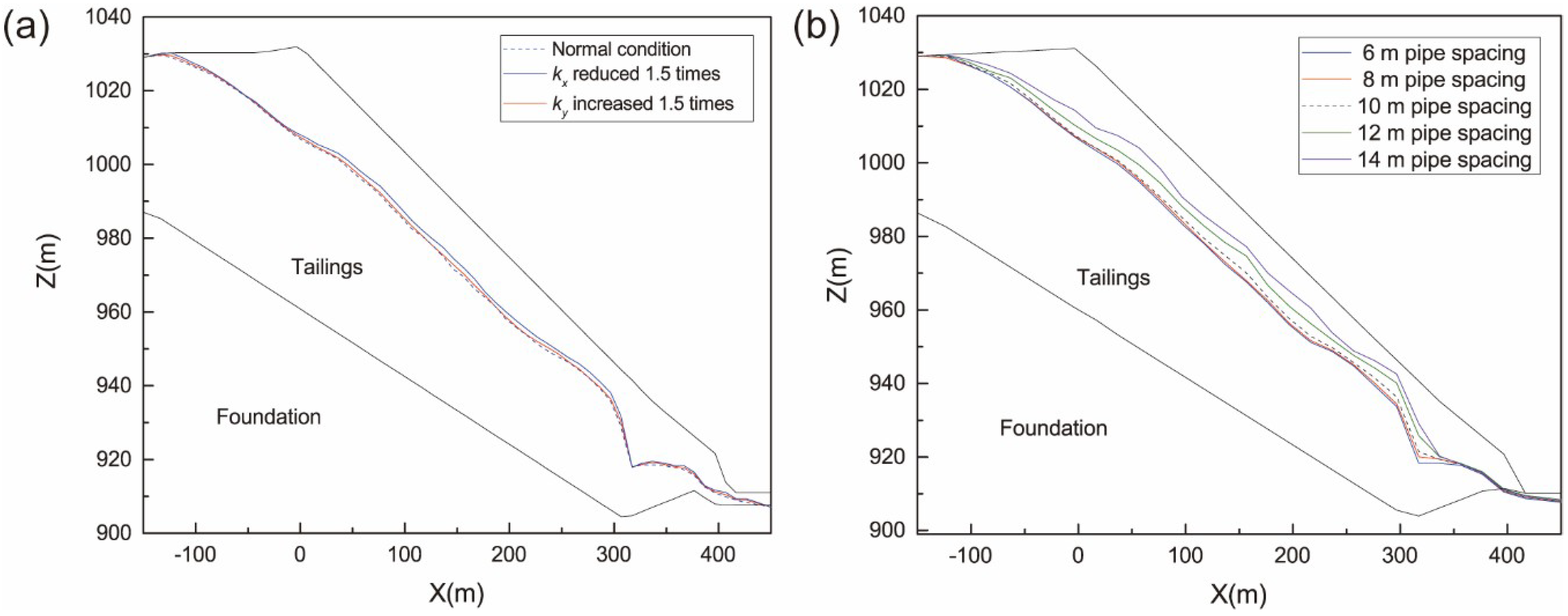
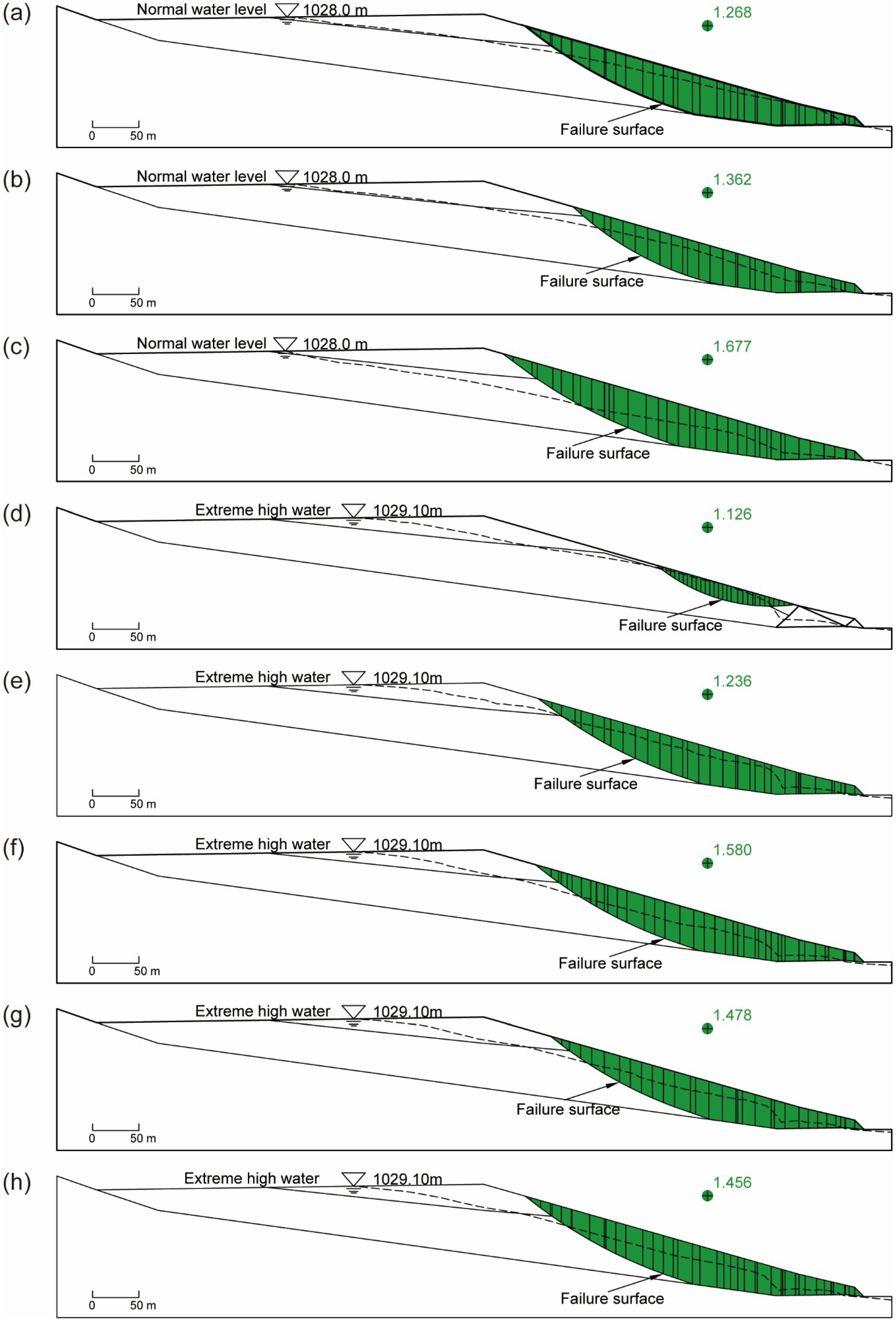
| Tailings d0.075/% | 95 | 90 | 80 | 70 | 50 | 40 | 30 | 20 | 10 | 5 |
| Filtering Net Mesh Numbers | 120 | 120 | 100 | 100 | 80 | 80 | 60 | 60 | 60 | 60 |
| Parameters | Permeability Coefficient (cm/s) | Corrected Permeability Coefficient (cm/s) | ||
|---|---|---|---|---|
| Horizontal kx | Vertical ky | Horizontal kx | Vertical ky | |
| Moderately weathered crystal tuff | 2.3 × 10−7 | 2.1 × 10−7 | 2.5 × 10−7 | 2.3 × 10−7 |
| Strongly weathered crystal tuff | 5.7 × 10−5 | 4.8 × 10−5 | 5.7 × 10−5 | 4.8 × 10−5 |
| Initial dam | 3.3 × 10−3 | 3.3 × 10−3 | 1.5 × 10−3 | 2.1 × 10−3 |
| Silty sand tailings | 5.0 × 10−4 | 4.5 × 10−4 | 5.1 × 10−4 | 4.3 × 10−4 |
| Silty soil tailings | 8.0 × 10−5 | 6.4 × 10−5 | 8.2 × 10−5 | 7.1 × 10−5 |
| Silty clay | 1.4 × 10−5 | 1.2 × 10−5 | 3.2 × 10−5 | 2.5 × 10−5 |
| Artificial clay I | 5.1 × 10−5 | 5.1 × 10−5 | 5.1 × 10−5 | 5.1 × 10−5 |
| Artificial clay II | 3.3 × 10−3 | 3.1 × 10−3 | 5.0 × 10−2 | 4.3 × 10−3 |
| Parameters | Volume-Weight (kN/m3) | Soil Indicators in Nature | ||
|---|---|---|---|---|
| Unity Weight (γ) | Saturated Unity Weight(γd) | Cohesion (c’) (kPa) | Friction Angle (ϕ’) (°) | |
| Moderately weathered crystal tuff | 26.9 | 27.9 | 2000.0 | 38.0 |
| Strongly weathered crystal tuff | 24.5 | 25.5 | 50.0 | 27.0 |
| Starter dam | 21.0 | 21.9 | 18.0 | 24.0 |
| Silty sand tailings | 19.2 | 20.1 | 4.0 | 30.0 |
| Silty soil tailings | 19.9 | 20.9 | 8.0 | 27.0 |
| Silty clay | 19.7 | 20.6 | 24.0 | 20.0 |
| Artificial clay I | 21.0 | 20.8 | 18.0 | 24.0 |
| Artificial clay II | 22.0 | 21.7 | 12.0 | 20.0 |
| Condition | Case | Factor of Safety | ||||
|---|---|---|---|---|---|---|
| The Ordinary Method of Slices | Bishop’s Simplified Method | |||||
| Calculated | Standard | Calculated | Standard | |||
| Normal water level | No drainage | a | 1.235 | 1.25 | 1.268 | 1.35 |
| Horizontal drainage | b | 1.321 | 1.25 | 1.362 | 1.35 | |
| New drainage | c | 1.542 | 1.25 | 1.677 | 1.35 | |
| Extremely high water | No drainage | d | 1.063 | 1.15 | 1.126 | 1.25 |
| Horizontal drainage | e | 1.142 | 1.15 | 1.236 | 1.25 | |
| New drainage | f | 1.521 | 1.15 | 1.580 | 1.25 | |
| kx reduced 1.5 times | g | 1.437 | 1.15 | 1.478 | 1.25 | |
| ky increased 1.5 times | h | 1.415 | 1.15 | 1.456 | 1.25 | |
| Earthquake | i | 1.106 | 1.05 | 1.165 | 1.15 | |
© 2018 by the authors. Licensee MDPI, Basel, Switzerland. This article is an open access article distributed under the terms and conditions of the Creative Commons Attribution (CC BY) license (http://creativecommons.org/licenses/by/4.0/).
Share and Cite
Liu, C.; Shen, Z.; Gan, L.; Xu, L.; Zhang, K.; Jin, T. The Seepage and Stability Performance Assessment of a New Drainage System to Increase the Height of a Tailings Dam. Appl. Sci. 2018, 8, 1840. https://doi.org/10.3390/app8101840
Liu C, Shen Z, Gan L, Xu L, Zhang K, Jin T. The Seepage and Stability Performance Assessment of a New Drainage System to Increase the Height of a Tailings Dam. Applied Sciences. 2018; 8(10):1840. https://doi.org/10.3390/app8101840
Chicago/Turabian StyleLiu, Chong, Zhenzhong Shen, Lei Gan, Liqun Xu, Kailai Zhang, and Tian Jin. 2018. "The Seepage and Stability Performance Assessment of a New Drainage System to Increase the Height of a Tailings Dam" Applied Sciences 8, no. 10: 1840. https://doi.org/10.3390/app8101840
APA StyleLiu, C., Shen, Z., Gan, L., Xu, L., Zhang, K., & Jin, T. (2018). The Seepage and Stability Performance Assessment of a New Drainage System to Increase the Height of a Tailings Dam. Applied Sciences, 8(10), 1840. https://doi.org/10.3390/app8101840






